In this article, we will discuss the features of food delivery apps and the main characteristics you need to create an online ordering and delivery application like Glovo or Uber Eats.
The purchase of goods and food delivery services to your home or office is a business that has been growing for several years, and in times of crises and epidemics, it accelerates its growth at times. Delivery of ready-made food has become commonplace for most families, and in the coming year, the turn will come to other types of goods, for example, we will more often order groceries at home and cook ourselves. Wasting time shopping will be ineffective. Already, many people send keys, documents, and small packages to each other by taxi. With the development of the walking courier industry, this service will become cheaper and more in demand.
In this article:
Why do you need to launch the application now?
Smartphone usage surpasses PC usage, with around 70% of individuals relying on smartphones for various aspects of daily life.
Mobile applications have become integral across different domains, ranging from communication to shopping, banking to taxi services, making smartphones indispensable.
Implementing a food delivery application facilitates mobile operations, enabling employees to handle more orders efficiently and increase profitability.
App users exhibit higher conversion rates and repeat purchases compared to website users, indicating greater engagement and loyalty.
Mobile applications offer enhanced convenience and personalized experiences, fostering stronger consumer ties and encouraging more frequent service usage.
Launching a food delivery app now capitalizes on prevailing consumer trends, promising operational efficiency gains and improved customer retention.
We're ready to contribute to the growth and success of your retail business!
See what our retail software development services can do for your business – we offer customized solutions for optimal performance.
Food delivery app business models 2024
According to analysis by consultancy McKinsey, all modern online meal delivery apps can be divided into three categories. Each of them has its own characteristics in the food order app features.
Aggregator model
Food delivery business model that works like a marketplace: the web platform provides a platform where restaurants can specify menus and prices, and users can compare them and place an order immediately. The restaurant is in charge of food preparation and delivery. The online food delivery app acts as a bulletin board and financial intermediary (not always) that accepts payment from the user and transfers it to the restaurant.
These applications account for the majority of the market. The most popular aggregators are GrubHub, Eat24, and Just Eat. This type of food delivery app development requires the creation of functionality for two user roles: the buyer and the restaurant. The other two food business models (logistics services and cloud kitchens) require the creation of features of food delivery apps for three roles: customer, restaurant, and courier.
New delivery services, or applications with logistic support
Similar to aggregator apps, it allows shoppers to order food online at different pizzerias, restaurants, cafés, and other food preparation establishments, while also helping with Uber food delivery. For restaurants, this is a godsend, as new services allow any restaurant, pizzeria, coffee shop, or even your grandma to make the best apple pie this side of the Mississippi to market.
New services work according to a simple scheme:
1) the client makes an order using necessary mobile food online ordering app features
2) the order is sent to the restaurant
3) the restaurant prepares the food and hands it over to a freelance courier
4) the courier takes the order to the client's doorstep. This business model is used by UberEATS, Foodpanda, Postmates, and Caviar
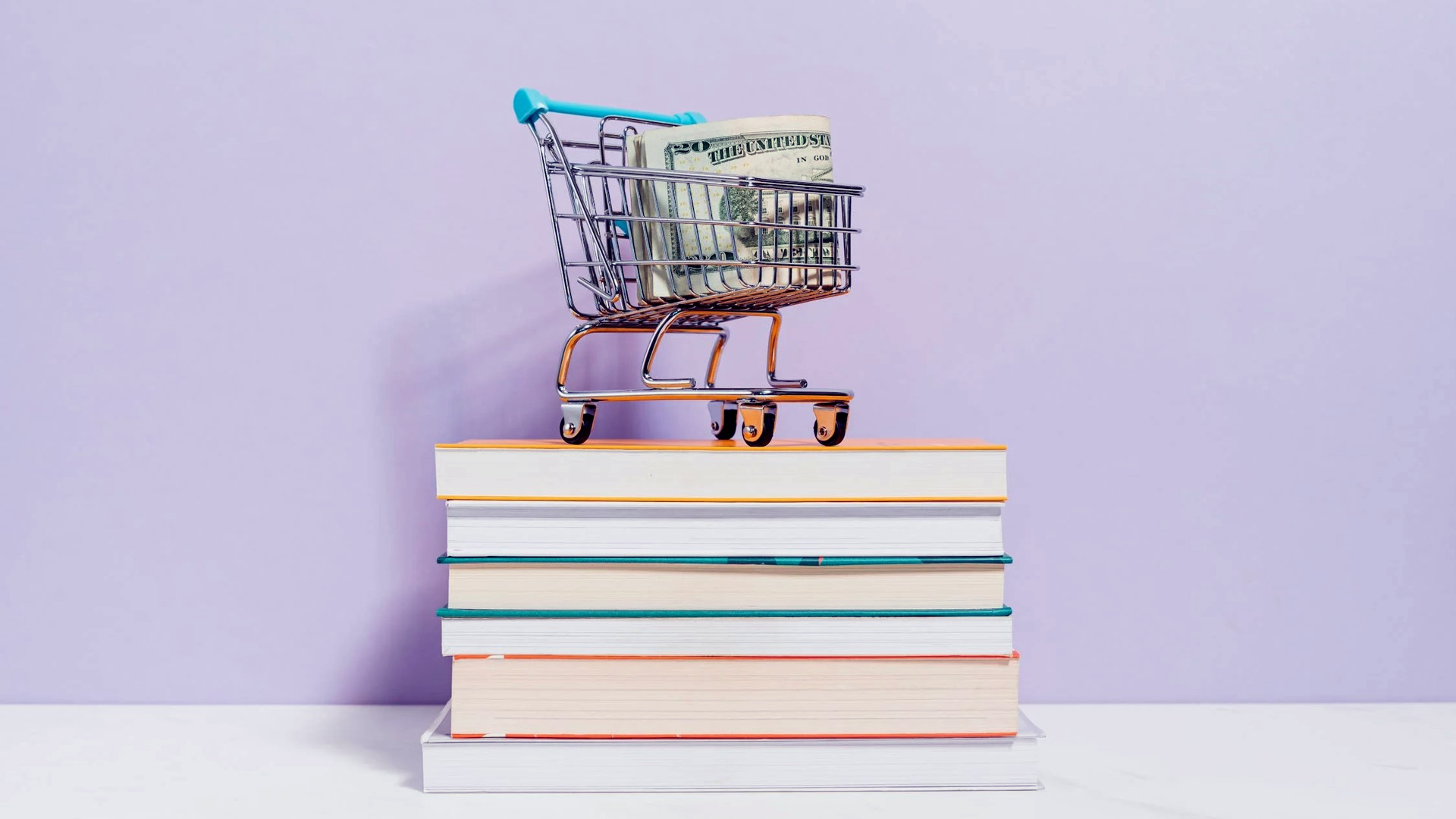
You may be interested
How to improve website customer experience: from date to marry
Learn how to transition users seamlessly from their initial interaction ('date') to a lasting commitment ('marry'), ensuring a positive and enduring connection.
Continue readingThis business model is used by UberEATS, Foodpanda, Postmates, and Caviar
Launching such food delivery apps requires the same efforts as developing an aggregator application, plus creating functionality for couriers and their interactions with restaurants and customers: order acceptance, real-time chat, location tracking, financial calculations, and more.
Full delivery service upon request
This scheme assumes working with kitchens that work exclusively on online delivery. Such kitchens are commonly referred to as cloudy or ghostly. Cloud kitchens do not have lounges, bar counters, or windows for on-site customer service. They take orders online, prepare food, and ship it to the delivery address. Such web services also have their own couriers.
When creating such an application, you need to know that it contains not only essential food delivery application characteristics but also open (buy) kitchens and hire the appropriate staff. In this case, the mobile food delivery service app works as an online menu, a cash register, and a map to track the status of the order and / or the location of the courier. Sometimes such services are also responsible for the document flow and accounting of the company (this is more convenient).
The largest network of cloud kitchens is Indian Rebel Foods (until 2018 was called Faasos), which recently received $ 170 million in investments from McKinsey, Goldman Sachs, Coatue Management and Gojek. In America, the cloud kitchens market plans to conquer the startup Deliveroo, which has raised $ 575 million in investments led by Amazon.
How to create a restaurant delivery app?
At the start of a delivery business, aggregator services help a lot: you do not need to rack your brains over the organization of the logistics scheme. But the cost of timely delivery turns out to be cosmic: about $5-$10 per order. In this case, the order can be $30, for example.
As a rule, they work with aggregators at low speeds, but as soon as an opportunity arises, they immediately launch their own application. This drastically reduces the cost of delivery and improves its quality. All these services have a lot of low ratings in their reviews. The selection of couriers is not particularly controlled, no one is watching them, and restaurants suffer from this.
Pros of cooperation with aggregators for restaurants
The first thing each establishment fights for is recognition and the number of orders. The owners of aggregator sites invest large sums of money in the mobile app development and improvement of the interface. This allows us to guarantee:
Increasing the number of ready-to-eat food delivered.
Increased turnover.
Company awareness.
Regular customers who, once contacting you, will continue to order food.
Currently, aggregators charge a higher percentage for mediation. However, these sites are the main suppliers of customers in the world. Later, people can go to your site and place an order directly. The person becomes your direct client. And his orders created directly on your site do not require interest payments.
Cons of cooperation with aggregators for restaurants
Create a name for the intermediary. Very often people remember the name of the place where they found your establishment. Thus, with your work, you increase the prestige, attendance, and recognition of the intermediary who just accepted the order and handed it over to you.
Increased percentage. This has already been discussed earlier. Restaurants operate with practically no profit, as they have to pay a percentage for each order. The average markup for a dish is about 20%. You pay this amount for the fact that the person made an order through the distributor.
Clients go to competitors. When there is a choice among establishments, people start comparing. And if initially they wanted to order food in one restaurant, now there is a temptation to try something new. People start to choose; customers who were initially targeted at you leave for other companies with better deals.
Repurchase of advertising. Internet advertising of your restaurant is, in most cases, bought by food aggregators. A person who is looking for your restaurant wants to order dishes, follows the link and goes to the aggregator's website, and not to your restaurant. Here, the visitor leaves an application that was originally intended for your restaurant. Thus, you lose part of your profit, paying a considerable commission to the aggregator. For this reason, many restaurateurs refuse to cooperate with aggregators or prohibit the use of brand names and signature dishes in aggregator's ads.
There is another way to solve the delivery issues — create custom takeaway online food delivery app characteristics from scratch.
Pros of your own delivery app
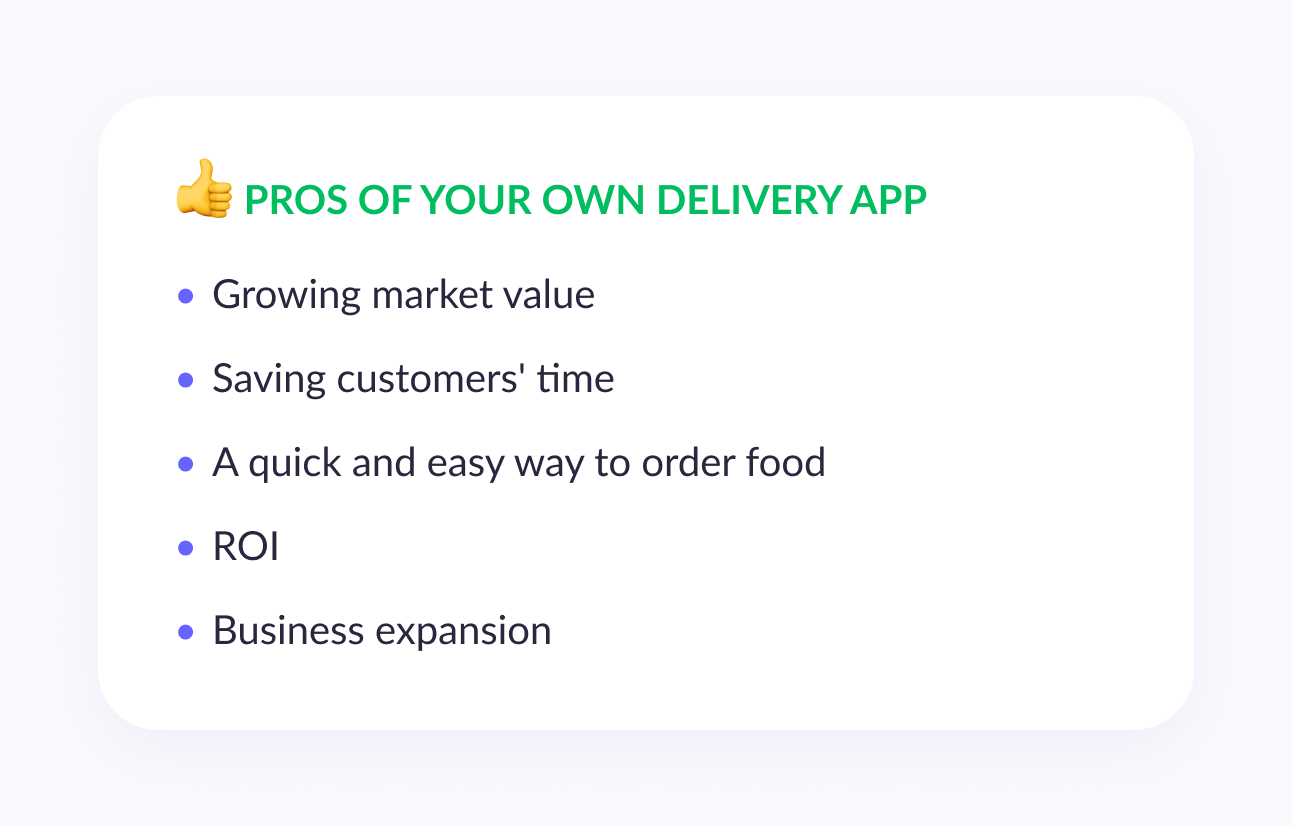
Growing market value. The development of the company is impossible without attracting new customers and making a profit. The introduction of new technologies will allow not only acquiring new customers but also increase their brand loyalty, thanks to which the average check also increases. The consequence of this for the company is a growing market value. Developing a meal delivery app is an investment in a company that will certainly pay off if the business is properly organized.
Saving customers' time. Many clients are ready to pay a lot of money to visit an establishment, but are not ready to pay with time. Going to a restaurant with disgusting service, food, and a poor menu is half the problem. The client most often feels sorry for the time spent. The food delivery mobile application reduces the likelihood of hitting such establishments. The user can study the menu, prices, and place an order at a convenient time. This is a great benefit for the restaurant. The credit of trust immediately increases, and the same client will be ready not only to order online, but also to visit the institution.
A quick and easy way to order food. The easier it is to place an order, the better for the client. The person does not want to waste time choosing. At any time, the user should be able to order food, and not go to an institution, wait until everything is cooked. Therefore, a mobile app for food delivery is a great opportunity to order quickly and easily.
ROI. This is an indicator of the return on investment, or, more simply, the payback ratio. Developing a food delivery application is an investment that will increase your ROI. After all, a person will not go to an institution on the other side of the city, but will be able to order food home if a courier brings him. Expanding the audience, increasing the receipt, properly optimizing the operation of the enterprise (delivery of several orders, blanks, and so on) - all this has a beneficial effect on ROI and increases profits.
Business expansion. The introduction of new technologies helps to significantly expand the business. First, the number of customers increases, ordering at the establishment becomes more accessible, simpler and clearer. In parallel, the assessment of the state of the business is carried out, reviews are collected, and adjustment is made to the needs of customers. All these changes have a positive effect on the development of the company and the business is expanding.
Cons of your own delivery app
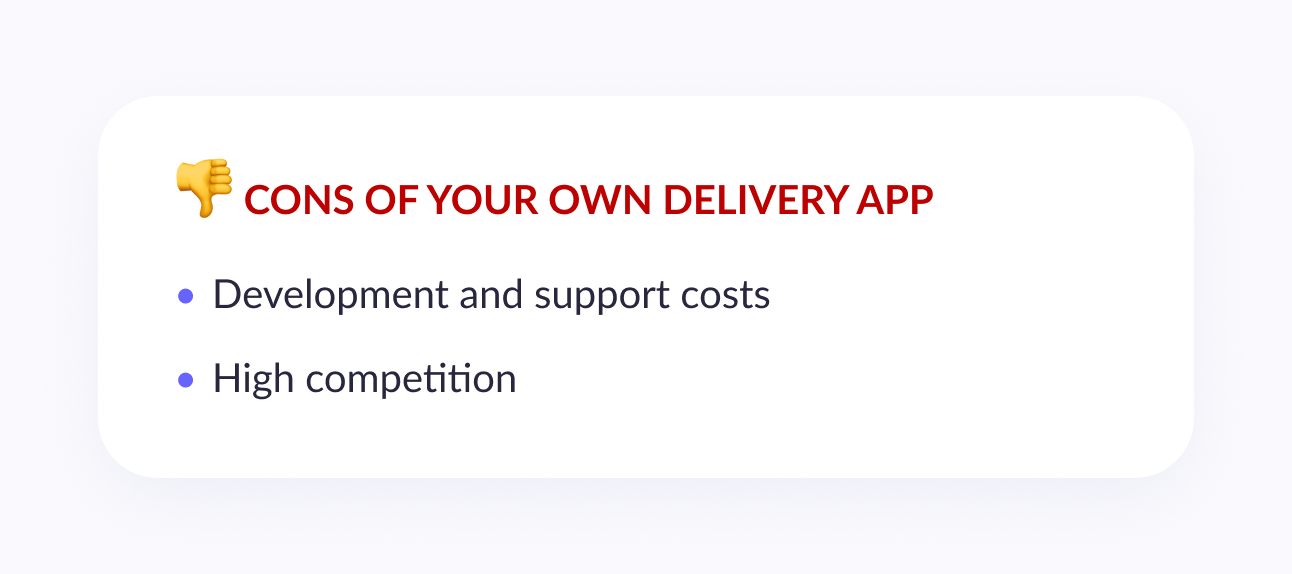
Development and support costs. For starters, a full-service food delivery business requires a significant capital investment. You will have to purchase expensive equipment and pay for the labor of many employees. Add to this the various types of insurance and permits you need to comply with laws and health regulations.
High competition. Launching a food delivery platform can be trickier than you think, primarily due to fierce competition. Today, Grubhub is one of the industry leaders, working with 300,000 restaurants serving takeaway food in 3,200 US cities and London. For a small company that is just entering the market, it would be quite difficult to surpass this giant. The list of startups that have already merged with Grubhub includes Seamless, MenuPages, LevelUp, and Allmenus.
Food delivery app features [customer app]
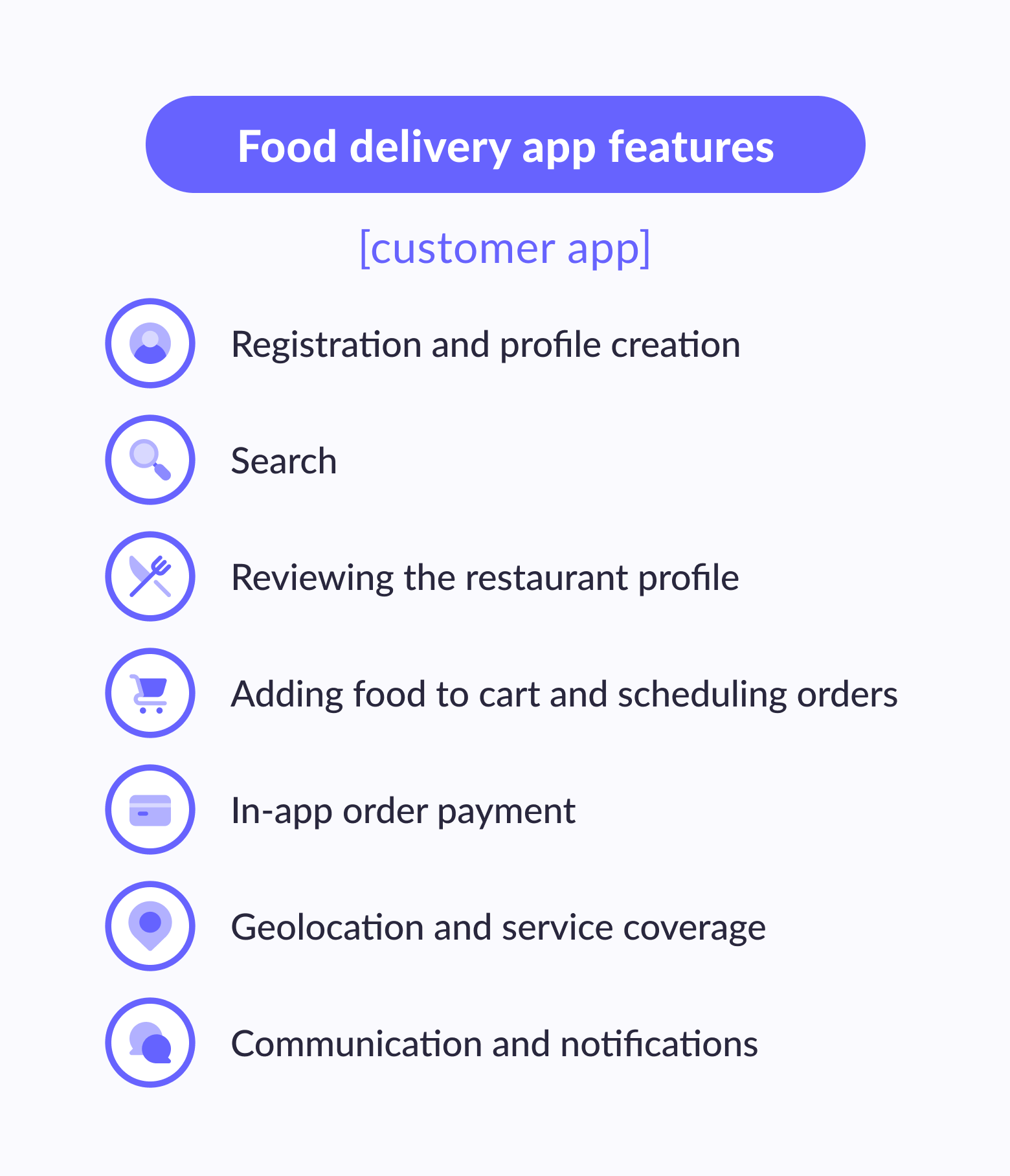
In this block, we will discuss the food delivery app features list required for the client application.
Registration and profile creation
Registration is an integral part of applications where there are payment gateways and work with personal data. Modern applications usually have several registration options:
via email;
via phone and SMS verification;
through integration with social networks (Facebook, Instagram, Twitter).
In addition, almost all applications can register through integration with Google Play and/or the App Store. This is very convenient for users who are used to making payment processes using Google Pay and/or Apple Pay.
Search
An important task of mobile food delivery apps is to organize a convenient search, search filters, and menu. The search must be done in such a way that the system “understands” what is wanted from it. Users may not know what the dish is called, so a detailed study of the search functionality is a necessary stage of development.
The menu should also be convenient and multifunctional. You can divide into categories, establishments, types, and types of dishes. It is better if there are as many ways as possible to find and choose the right dish.
check which product they have chosen and complete the checkout
find out how much purchase costs
check if all the necessary dishes have been purchased
refuse emotional purchases


Thank you for Subscription!
Reviewing the restaurant profile
Before ordering food, the client should familiarize himself with the dish, and the best way to do this is to study the ratings and reviews about the institution and the dish itself. Reviews help both sell and buy. Ratings and reviews have become the primary source of product information. Thus, 95% of respondents reported that they read customer reviews, of which 24% do it before each purchase.
Adding food to the cart and scheduling orders
The main goal of any food delivery application is to sell goods. One of the main tools for making in-app sales is, of course, the shopping cart. An online shopping cart is a page where a customer submits products in order to purchase them.
This is comparable to shopping at a regular supermarket. You walk around with a basket, which you fill with products, and at the checkout, you pay for its contents.
The cart interface in the shipping application is must-have so that customers can:
In-app order payment
If the food delivery apps accept payment for orders or is an intermediary in this process, you will need integration with payment gateways. Choosing the right mobile wallet app services and connecting them is a very serious task since payment should be convenient and at the same time secure.
To achieve this, it is recommended to use reliable payment gateways — services that connect a web service to several payment options at once (Apple Pay, Google Pay, PayPal, bank cards, etc.). This can save hundreds of development hours and reduce the cost of developing applications.
Payment gateways can be of two types:
Classic. They require a trading account with a bank. Suitable for enterprises working with large transaction volumes, thanks to which you can get more favorable conditions from banks and payment services (the larger the volume, the lower the commission). Examples of classic gateways are 2Checkout, WorldPay, and Authorize.Net.
Modern. You need a regular bank account to receive payments, which simplifies the integration process, but involves higher fees. Examples: PayPal and Stripe. Modern gateways are usually used by companies that want to save money at the start.
To ensure the security of transactions, application development must comply with data security standards (depending on jurisdiction) and be PCI DSS compliant.
Geolocation and service coverage
All modern online food delivery apps are closely related to navigation. They track the user's position and display the nearest restaurants in the search, help track the location of the courier, help the courier plan a route from the restaurant to the delivery point, and more.
These functions require interaction with users' GPS chips and online maps. That said, geolocation tools differ depending on the platform. So, iOS usually uses MapKit, Android — Google Maps, so development hours for these platforms may differ.
Communication and notifications
Notifications help users keep track of important events: payment of an order, delivery of food to a courier, approach of a courier to a delivery point, arrival of a courier, and more. This can improve the user experience and thereby increase user loyalty.
Usually, two types of notifications are used for this:
Push notifications. Messages that pop up on the smartphone screen even if the application that triggers this notification is closed.
SMS. Sending a short text message to a phone number.
In order not to duplicate messages and thus annoy users, developers, as a rule, use a simple rule: first, a Push notification is initiated, and only if it has passed, an SMS is sent. Push notifications may fail if the phone has no internet connection.
Food delivery app features [administrator app]
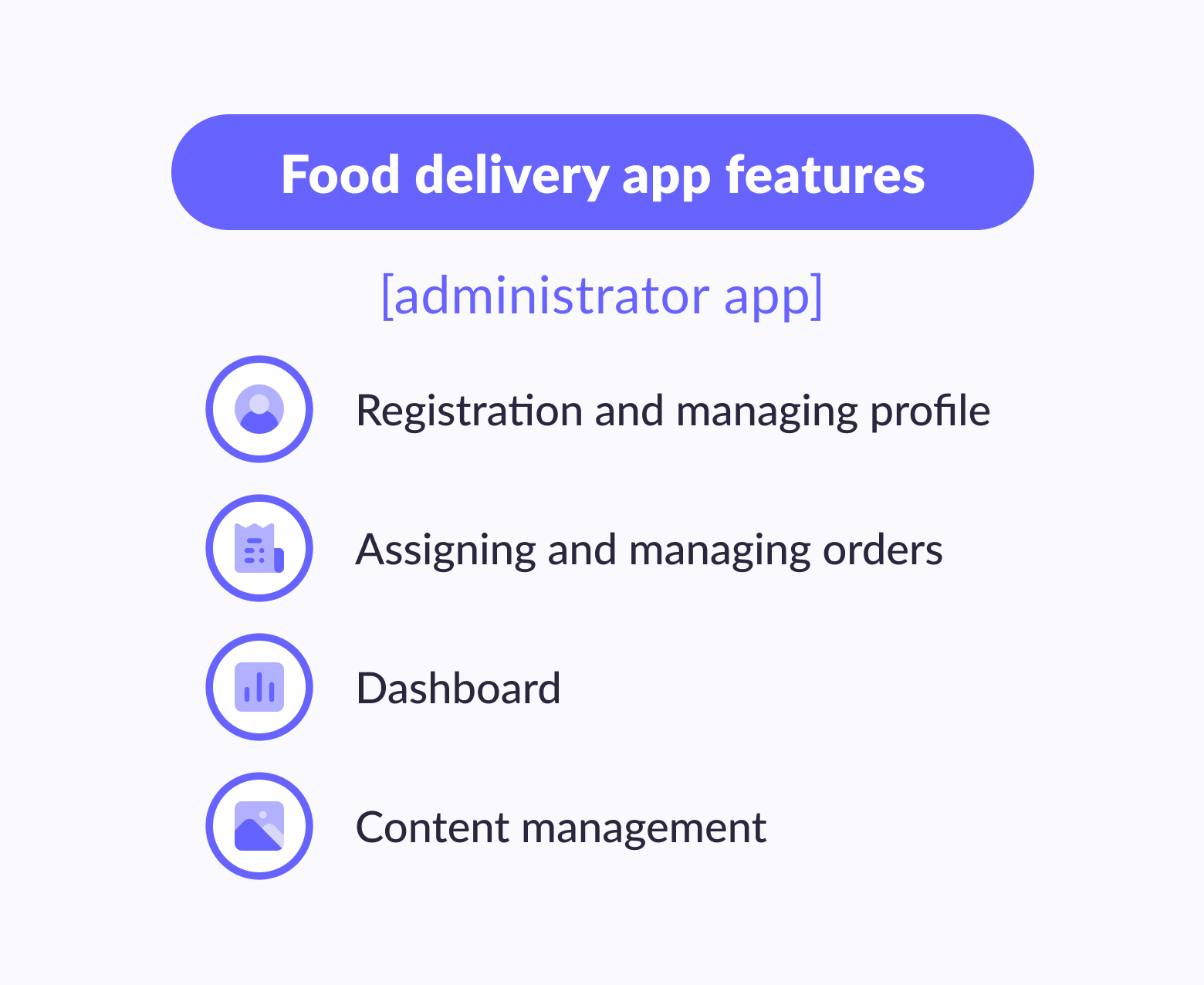
In this section, let's take a closer look at all food delivery app development features necessary to create a full-fledged application for the Administrator.
Registration and managing profile
This section stores information about all customers and couriers of the restaurant who have registered and agreed to leave their data with you. Information about them can be edited and deleted. It is also possible to group customers by some criterion, for example, by subscribing to mailing lists or by gender. This is very convenient since you can only inform a specific target audience about a particular promotion or sale.
Assigning and managing orders
The client adds the selected goods to the "Cart" on the site and place an order. What happens next? The application is sent to the manager, who sees it in the administrative panel. This happens due to the integration of the CMS, which runs the online store, and CRM. Moreover, the changes should be uploaded in both directions in order to avoid data loss.
After the application is processed, the manager monitors the order. He gradually changes the status of the order - from approval to packaging, then to the fence from the restaurant, then to delivery. Thus, a full-fledged picture of the application for the delivery of food from a restaurant is formed - you can see at what stage each order is. For each order in CRM, you can set tasks: "call back", "clarify", "find out".
Dashboard
The name of this item in the administrative panel speaks for itself. Here you can find a variety of reports on the restaurant's work This is the number of orders, the number of users, coupons and gift certificates used, the number of refunds. Also, the number of dishes viewed and purchased, bonus points awarded and the amount of commission paid to partners.
Content management
The key advantage of a delivery application with an installed content management system is the presence of an interactive interface that allows you to interact with published materials and already added graphic, text files in a visual mode. Without a CMS, you have to deal with the tasks manually, looking inside the components located in the database of the selected hosting. For example, pictures are loaded through the admin panel through a special editor, where from the necessary actions - click on the icon of the desired action, and then select the file on the hard disk.
Without the admin panel, you will have to work with content as follows:
Upload a picture to the hosting;
Find the section in the database, page HTML or CCS styles where you want to add a new image;
Use tags to create a link to an image (remembering that you cannot make mistakes, because the added code can destroy other elements on the site);
Check the content of the web page.
So, we can conclude that the delivery application management system is a very powerful and flexible tool for your business, it has a large number of modules. All that remains for you is to hire administrators who will introduce a new assortment of dishes, monitor delivery, and communicate with customers and couriers.
Food delivery app features [courier app]
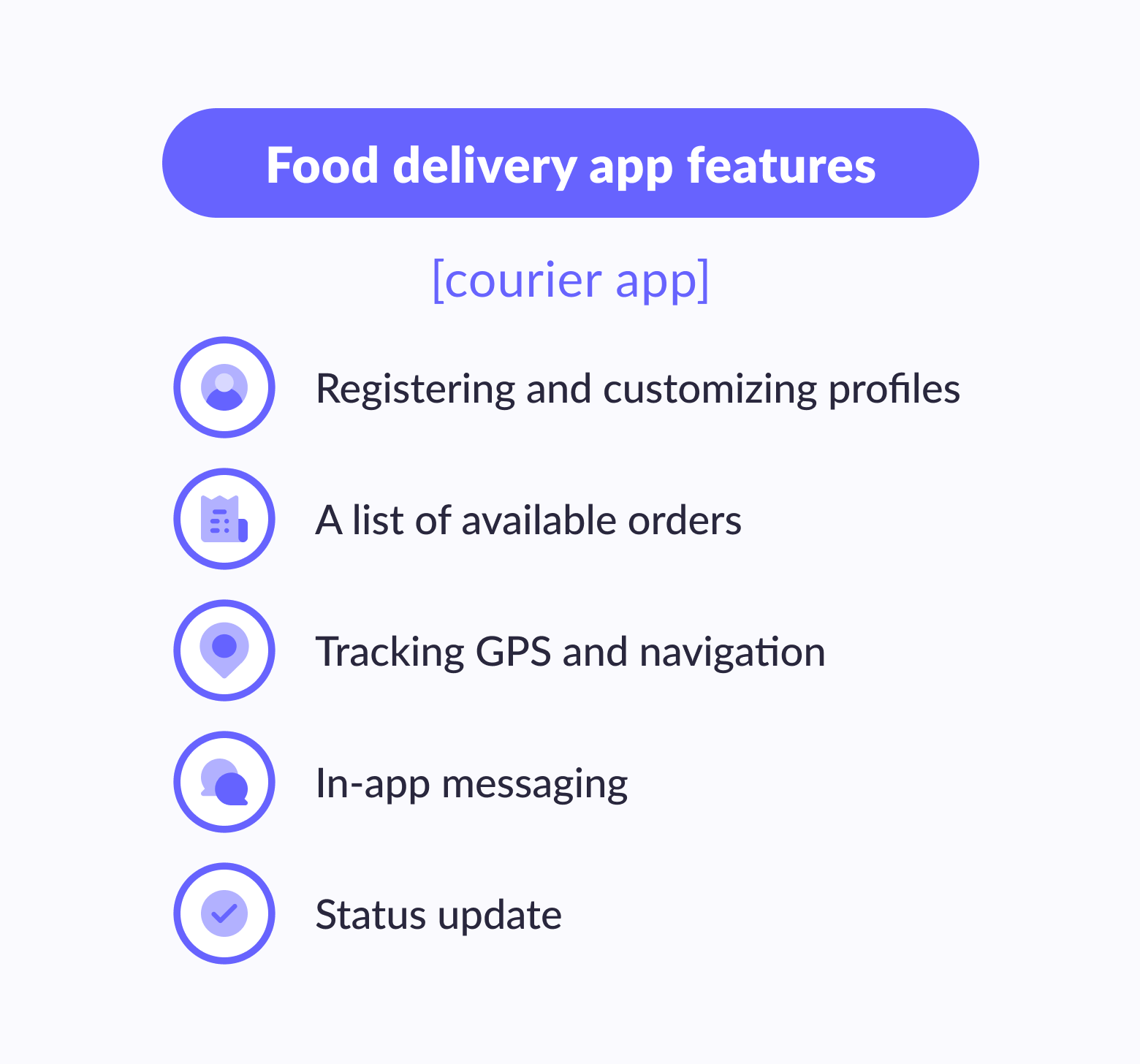
Below we will analyze the essential features necessary for a quality delivery courier app.
Registering and customizing profiles
The personal profile of the delivery personnel in the delivery application means collecting personal and delivery person's contact information during registration, as well as their reviews and ratings in the future. Also, the courier's personal profile contains a complete order history and deliveries, preset parameters, and online payment information.
A list of available orders
On the working screen for the delivery person, a list of available orders that have not yet been picked up by any of the couriers should be selected. It is desirable that all orders are shown by default within a radius of 750 meters from the current location of the courier. Orders are usually sorted chronologically by arrival time — the courier should see the newest at the top. The list of orders should also contain information about the specified delivery time, the recipient's address and the customer's contact information.
Tracking GPS and navigation
Since food needs to be picked up from a specific point and delivered to a specific location, the map will be an important part of the application. But fear not — you don't have to write your own solution from scratch. You can use Google Maps or Open Street Maps (OSM) and just write your own functions to locate the device. You also need to add real-time order tracking, so customers know that their food is on the way.
It is also desirable that the program integrates with routing services that would help to quickly build optimal routes. This speeds up the work of the logistical by 5 times and reduces logistics costs by 20%. Smart order distribution and automatic route planning for each courier take into account the traffic situation and order grouping.
In-app messaging
In-app notifications are the type of notifications that are displayed to the user when the app is open. It can look like pop-ups or colorful interstitials — either way, they're all used for targeted or context-sensitive notifications.
In the case of a courier application, a messenger inside the application is must-have both for communicating with the customer and for clarifying details with the administrator.
Status update
Each order has a payment and processing status. The statuses help the courier understand what needs to be done with the order. For example, the courier sees that the order is being collected. This means that during this time he has the opportunity to get to the restaurant in order to pick up the order and deliver it to the recipient.
The courier can change the order status at any time. When he changes the status of the order, the customer is automatically notified of the change of status in the application.
Our experience
Our team has experience in how to develop an app for food delivery like Doordash. Our project is called the Tamam Delivery application. The client came to us with the idea to create their food delivery app for the Turkish market. The app had to be intuitive and responsive while processing a high load of data. More intuitive design is very important for a more enjoyable customer journey, and for contributing to higher conversion.
That's why our process started with the initial brainstorming discovery phase, where we defined the product boundaries, defined the work scope, created the work breakdown structure, wrote the user story, and created architectural diagrams. Next during the UX / UI phase, we made web frames and tested prototypes of mobile web for admin, courier application, and client app.
While creating an on-demand delivery app front-end, we were focusing on improving each step of the user journey — from browsing through the products and places where you can make an order to customize the order and adding products to the basket to transaction completion using secure payment methods.
We chose React.js, Node.js,and React Native for food delivery app development because these tools are modern, advanced, and easy to maintain. In addition, these frameworks are based on the same JavaScript language. Our experience with this stack of technologies shows that it allows fast implementation of new features.
You can also be interested in“How to build a food delivery app like Doordash or Uber Eats?”

Conclusion
In this article, we have shared with you all the necessary food delivery app features to create a top competitor in the delivery market. Food delivery is one area where the Uber for X model is successful. Our team will be happy to help you create complex on-demand food delivery platforms.
Fill out the contact form for our specialist to contact you and tell you about the cost and terms of your restaurant app development. The consultation is free and helpful.





















